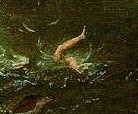You can see a large format version of Bruegel's 1558 painting here. And there is a brief bio of Pieter Bruegel the Elder here; it places Bruegel in the context of 16th century Flemish narrative painting, marks his Italian training, and indicates the influence of Hieronymus Bosch.
Make sure you spot the following element of the painting. It's easy to miss:

Those are Icarus's legs.
What should be a story of the spectacular failure of human ambition is represented by Bruegel in a dim corner of the canvas, dwarfed by the scale of a massive landscape, and overlooked by nearly all of the human characters in the painting.
Compare the painting to Auden's poem of 1938:
Musée des Beaux Arts
by W.H. Auden
About suffering they were never wrong,
The Old Masters: how well they understood
Its human position; how it takes place
While someone else is eating or opening a window or just walking dully along;
How, when the aged are reverently, passionately waiting
For the miraculous birth, there always must be
Children who did not specially want it to happen, skating
On a pond at the edge of the wood:
They never forgot
That even the dreadful martyrdom must run its course
Anyhow in a corner, some untidy spot
Where the dogs go on with their doggy life and the torturer's horse
Scratches its innocent behind on a tree.
In Brueghel's Icarus, for instance: how everything turns away
Quite leisurely from the disaster; the ploughman may
Have heard the splash, the forsaken cry,
But for him it was not an important failure; the sun shone
As it had to on the white legs disappearing into the green
Water; and the expensive delicate ship that must have seen
Something amazing, a boy falling out of the sky,
Had somewhere to get to and sailed calmly on.
(Incidentally, to answer the question of how you can prove the presence of irony to readers unaccustomed to poetry, there isn't any easy formula. The most solid -- or most teachable -- approach I can think of hinges on the dissonance between words indicating tone: "leisurely" does not go with "disaster," and "amazing" does not go with "calmly." It's in the gap between words describing a single event that you'll find Auden's irony.)
What's interesting about this poem more generally is the way Auden breaks the narrative frame, implicating the viewer of the painting as well as the reader of the poem in the ethical crisis occurring at the margin. While in the first and third stanzas Auden offers a reflection on the painting itself, in the second stanza he seems to wander off topic somewhat. The Crucifixion was a common enough theme for the "Old Masters" such as one would see in this museum in Brussels. But children skating on a pond? And most importantly, where does he get the "untidy spot/ Where the dogs go on with their doggy life and the torturer's horse/ Scratches its innocent behind on a tree"?
These mundane and perhaps contemporary elements from outside the painting extend the theme of social indifference to include the reader in the present day. It's we who, in the face of war and injustice, continue steadfastly on our course as if nothing dramatic is happening, just as the "expensive delicate ship . . . sailed calmly on" in Auden's poem.
Of course, it's quite fair to suggest that Bruegel himself accomplished much the same breaking of the narrative frame in his 1558 painting, though in Bruegel's case at least the marginalization of Icarus is part of a deliberate joke on the viewer. (Where Bruegel makes disaster marginal, Auden reminds us to keep our eyes focused on the margins. And perhaps the idea of an ethics of social concern that is so important to Auden was not in Bruegel's mind, Icarus being a mythical figure.)
In his essay on the painting and Auden's poem at Critical Inquiry, I think Nemerov errs slightly when he argues that Bruegel's gesture is somehow contemporary:
But if we focus still more on the figure of Icarus, we can begin to see that the painting becomes, thanks to Auden's poem, not just an allegory of 1938 but something somehow made in 1938, as though it were a surrealist work of the poet's own era.
I don't think such strong phrasing is necessary. And I'm also not sure that Nemerov's invocation of Borges's "Pierre Menard" is warranted, though the poem and painting may well be a Mise-en-abyme -- for which a reference to Borges may always be warranted.
Finally, if one were to teach the poem and painting today, one would be sorely tempted to talk about contemporary situations where it seems society continues to fail to address its ethical blindspots. (Auden's disquieting reference to "the torturer's horse" might provide a convenient segué to a comment about Bush administration.) Some might complain about yet another instance of the politicization of literary studies, but in this case the poem itself seems to require it; politicization is embedded into the structure of the poet's own act of reading.